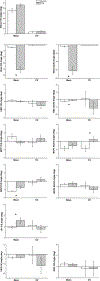Effects of Type II Diabetes on Proprioception during a Reach to Pinch Task
- PMID: 37997260
- PMCID: PMC10957313
- DOI: 10.1080/00222895.2023.2285888
Effects of Type II Diabetes on Proprioception during a Reach to Pinch Task
Abstract
Older adults with type II diabetes (T2D) are at risk of developing nerve disorders that result in functional impairment. Most work in proprioceptive dysfunction in older adults with T2D has focused on functional deficits of the lower limb. The purpose of this study was to examine proprioceptive effects of T2D on the upper limb in older adults. Kinematic performance of a reach-to-pinch action toward a virtual target was assessed in a T2D group (60+ years old with T2D) and a healthy age- and sex-matched control group. Tactile and vibratory thresholds did not differ between T2D and controls. Task accuracy via mean pinch location was significantly worse for persons with T2D (pwT2D) with differences in wrist extension/flexion (ex/fl), wrist abduction/adduction (ab/ad), 1st carpometacarpal (CMC) ab/ad, 2nd metacarpophalangeal (MCP2) ex/fl, MCP2 ab/ad, and digit 1 and hand transport trajectories. Group differences persisted with consideration of body mass index; sex differences in task accuracy emerged. Findings indicate that proprioception of the upper extremity is altered in pwT2D such that they exhibit a unique aperture position and aiming strategy during a reach-to-pinch action. These findings characterize functional sensorimotor impairment of the upper limb in pwT2D with respect to workspaces without visual or tactile feedback.
Keywords: aging processes; kinematics; motor control; tactile; virtual environments.
Conflict of interest statement
Figures




Similar articles
-
The impact of diabetic peripheral neuropathy on pinch proprioception.Exp Brain Res. 2019 Dec;237(12):3165-3174. doi: 10.1007/s00221-019-05663-3. Epub 2019 Oct 4. Exp Brain Res. 2019. PMID: 31586215
-
Robot-Assisted Proprioceptive Training with Added Vibro-Tactile Feedback Enhances Somatosensory and Motor Performance.PLoS One. 2016 Oct 11;11(10):e0164511. doi: 10.1371/journal.pone.0164511. eCollection 2016. PLoS One. 2016. PMID: 27727321 Free PMC article.
-
Effects of a robot-aided somatosensory training on proprioception and motor function in stroke survivors.J Neuroeng Rehabil. 2021 May 10;18(1):77. doi: 10.1186/s12984-021-00871-x. J Neuroeng Rehabil. 2021. PMID: 33971912 Free PMC article. Clinical Trial.
-
A robot-aided visuo-motor training that improves proprioception and spatial accuracy of untrained movement.Sci Rep. 2017 Dec 6;7(1):17054. doi: 10.1038/s41598-017-16704-8. Sci Rep. 2017. PMID: 29213051 Free PMC article.
-
Sensorimotor interventions and assessments for the hand and wrist: a scoping review.J Hand Ther. 2014 Oct-Dec;27(4):272-85; quiz 286. doi: 10.1016/j.jht.2014.07.002. Epub 2014 Jul 24. J Hand Ther. 2014. PMID: 25193532
References
-
- Centers for Disease Control and Prevention. (2020). National Diabetes Statistics Report. 32. https://www.cdc.gov/diabetes/pdfs/data/statistics/national-diabetes-stat...
-
- Colberg SR, Sigal RJ, Fernhall B, Regensteiner JG, Blissmer BJ, Rubin RR, Chasan-Taber L, Albright AL, & Braun B. (2010). Exercise and type 2 diabetes: The American College of Sports Medicine and the American Diabetes Association: joint position statement. Diabetes Care, 33(12), e147–167. 10.2337/dc10-9990 - DOI - PMC - PubMed
MeSH terms
Grants and funding
LinkOut - more resources
Full Text Sources
Medical
